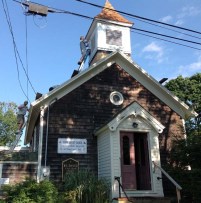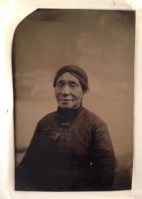Category: African Americans
5 Surprising Ways Historic Preservation Can Save Long Island
What better way to celebrate National Preservation Month than by interviewing Jason Crowley, Preservation Director of the Society for the Preservation of Long Island Antiquties (SPLIA)?
Jason comes to Long Island by way of Vermont, Charleston, Columbia University and years of work on the front lines of preservation. You’ll hear his take on the unique challenges and opportunities the Island represents, with our complicated map of towns, villages and hamlets accompanied by preservation laws of varying degrees of strength and effectiveness. We’ll also go over many of the local, state and national preservation agencies that you’ll want to tap when it comes time to fight for a historic site.
Founded during the post-World War II building boom on Long Island, SPLIA works to preserve all aspects of Long Island’s built environment in conjunction with partners from the East River to Montauk. Headquartered in Cold Spring Harbor, they own additional historic sites in Lloyd Harbor, East Setauket and Sag Harbor.
Finally, Jason and Connie compare notes on strategies to preserve historic landmarks, particularly religious buildings and the surviving works of noted Sayville architect Isaac H. Green.
And keep an eye out for SPLIA’s #MyLongIslandLandmarks exhibit opening in June.
Stream in the player above or download audio.
Further Research
Long Island
- Society for the Preservation of Long Island Antiquties
- Suffolk County Historic Services
- Friends of Connetquot River State Park Preserve
- Sag Harbor Historical Society
- Save Sag Harbor
- Long Island Modernism: 1930-1980 by Caroline Rob Zaleski (find in a library via WorldCat)
- A. Conger Goodyear House
- Association of Suffolk County Historical Societies (ASCHS)
- Long Island’s Chambers of Commerce
- “The Migration of Jupiter Hammon and His Family” (from the Long Island History Journal)
City
- New York City Historic Districts Council
- New York Landmarks Conservancy
- “New York City’s Landmarks Law at 50” (from the NY Times)
State
- New York State Historic Preservation Office
- Plan for Jones Beach State Park
- Preservation League of New York State
- New York Cultural Heritage Tourism Network
- Tax Credit Programs – Historic Preservation Office
- Sacred Sites (New York Landmarks Conservancy)
- Friends of the Winooski
National
A Neighborhood of History

St. David AME Zion Church in Eastville. Photo courtesy of the Eastville Community Historical Society.
Eastville endures. Through the rise and fall of the whaling industry, over the long slow death of slavery, past the rising tide of development on the East End of Long Island. From the early 19th-century this small collection of streets and houses east of Sag Harbor, anchored around the St. David AME Zion Church, has retained its character as a place that a vibrant mix of African Americans, Native Americans, and European immigrants called home.
On this episode of the Project, we speak with Dr. Georgette Grier-Key, Executive Director and Curator of the Eastville Community Historical Society. She relates the history of the area, from the early 1830s into the late 20th century when the Society was founded.

Portrait of an Eastville resident. Photo courtesy of the Eastville Community Historical Society.
You’ll hear about the prominence of Native Americans and African Americans in the whaling industry as well as the importance of Sag Harbor as the first port of entry in New York. Among the people we discuss are Nathan Cuffee, a Montaukett member of the community who co-wrote the novel Lords of the Soil in 1905, depicting life on the east end of Long Island. Georgette also tells the surprising story of Pyrrhus Concer from nearby Southampton, an African American who, on a whaling voyage in 1845, became one of the first Americans to visit Japan.
We also discuss the challenges of documenting and preserving the histories of marginalized people. How do you prove, for example, that one of the trapdoors in the Church was used to hide escaping slaves on the Underground Railroad? How do you protect an unassuming house that is actually made out of wood from recovered 19th century shipwrecks and may contain generations of important stories?

Courtesy of the Eastville Historical Society
Sometimes you get lucky and discover a trove of tintype portraits nailed face-down into the floor of a cottage. Sometimes you fail, and structures get razed despite what they might be able to tell us about the past. Sometimes the results are mixed. Pyrrhus Concer’s house was demolished but only after significant parts had been salvaged.
You’ll hear Georgette talk about these cases and related issues along with the importance of understanding and enforcing the codes that should be helping inform decisions around such properties. You’ll also hear about ongoing projects to document African American burial sites throughout Long Island.
And if you enjoy these episodes, make sure to follow this site via email or subscribe to the podcast in iTunes. Leave us a comment and let us know what aspects of Long Island history you’d like to hear discussed.
Stream in the player above or download audio.
Further Research
- Eastville Community Historical Society
- Sag Harbor Whaling Museum
- Sylvester Manor
- Lords of the Soil by Nathan Cuffee (via Google Books)
- Eastville Tintypes from Floor to Wall (East Hampton Star)
- Burial Database Project of Enslaved African Americans
- Slavery and Salvation: Long Island’s Underground Railroad (Long Island Press)
- Slavery in New York (New York Historical Society)


